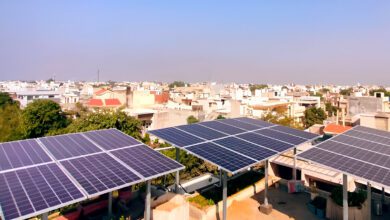The installed capacity of solar energy in India has witnessed an 18 times increase between 2014 and 2021, the Union government informed the Lok Sabha on Monday.
Responding to a query in the lower house, Minister of State for Environment Ashwini Choubey said India’s current share of non-fossil sources based installed capacity of electricity generation is more than 40%.
“Through the National Action Plan on Climate Change and its various national missions, India is addressing climate change mitigation and adaptation across a range of sectors. Installed capacity of solar energy in India has increased by more than 18 times from 2.63 gigawatt in March 2014 to 47.66 gigawatt in October 2021. As a result, India’s current share of non-fossil sources based installed capacity of electricity generation is more than 40%,” Choubey said.
He said under Unnat Jyoti by Affordable LEDs for All (UJALA) scheme, 36.78 crores LED bulbs have been distributed to enhance energy efficiency.
“Perform Achieve and Trade (PAT) scheme for energy efficiency in industries and other energy-intensive sectors resulted in total savings of approximately 13.28 million tonnes of oil equivalent, translating into 61.34 million tonnes of carbon dioxide equivalent of avoided emissions in the PAT Cycle II,” the minister said.
On another query on greenhouse gas (GHG) emissions, Choubey said according to India’s third Biennial Update Report submitted to the United Nations Framework Convention on Climate Change (UNFCCC) in February 2021, total GHG emissions, excluding Land Use Land-Use Change and Forestry (LULUCF) in 2016 were 2,839 million tonnes carbon dioxide-equivalent and 2,531.07 million tonne carbon dioxide-equivalent with the inclusion of LULUCF.
UNFCCC defines LULUCF as a greenhouse gas inventory sector that covers emissions and removals of greenhouse gases resulting from direct human-induced land use, land-use change and forestry activities.
As a party to the UNFCCC, India periodically submits its National Communications and Biennial Update Reports (BURs) to the UNFCCC which includes national GHG inventory, the minister told the Lok Sabha.
India’s total GHG emission also includes CO2 emissions from the oil and gas sector and industrial processes and product use sector.
The data showed that according to the three BURs, the GHG emissions in India have increased since 2010. According to the Environment Ministry, India’s total GHG emission without LULUCF has increased from 2137 million tons of CO2 equivalent in 2010 to 2839 million tons of CO2 equivalent in 2016.
Carbon dioxide emissions in India have increased from 1,574 million tons in 2010 to 2,231 million tons in 2016.
“India is making every effort to decouple its growth from emissions, by steadily lowering the emissions intensity of its GDP over the years. This keeps India’s GHG emissions below what would otherwise have been emitted. It is important to emphasise that there is no sector of India’s economy and no aspect of its economic life that is untouched by the concern to keep to a low-carbon development pathway,” Choubey told the Lok Sabha.
The Environment Ministry said that based on field surveys and satellite data, the National Centre for Sustainable Coastal Management has estimated the total extent of the seagrass ecosystem in India to be 516.59 square km.
“The carbon dioxide sequestration rate of the seagrass ecosystem is estimated to be up to 434.9 tonnes per square km per year with an annual net CO2 sink of 0.75 million tonnes for an area of 517 square km,” it said.
Further, the government has also initiated a project across Andhra Pradesh, Maharashtra and Odisha on enhancing the climate resilience of India’s coastal communities at a total cost of $130.26 million, the ministry said.
It includes a grant of $43.41 million by Global Climate Fund, covering 24 ecosystems in these selected states which aims to strengthen the climate resilience of coastal communities by protecting and restoring India’s natural ecosystems such as mangroves and seagrass, it said.













